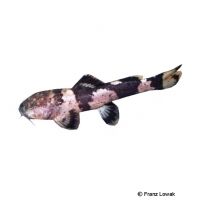Giant Bumblebee Catfish (Pseudopimelodus bufonius)
| Giant Bumblebee Catfish Pseudopimelodus bufonius | |
|---|---|
| Name | Giant Bumblebee Catfish |
| Name Lat. | Pseudopimelodus bufonius |
| Synonym | Pimelodus bufonius |
| Family | Dwarf Marbled Catfishes |
| Family lat. | Pseudopimelodidae |
| Order | Catfishes |
| Order lat. | Siluriformes |
| Origin | NE-South America |
| Habitat | Rivers, lakes |
| Diet | Carnivore |
| pH | 6.5-7.5 |
| Behavior | Nocturnal, peaceful |
| Keeping | Individual, group |
| Care Level | Moderate |
| Reproduction | Substrate spawner |
| Breeding | None reported |
| Life Span | 8-10 years |
| Protection | No |
| Metric Units | |
| Size | 18-20 cm |
| Temperature | 20-24 °C |
| Hardness | 5-15 °dH |
| Aquarium | 250 l |
| US Units | |
| Size | 7"-8" |
| Temperature | 68-75 °F |
| Hardness | 89-267 ppm |
| Aquarium | 65 gal |
Distribution and habitat
The crepuscular to nocturnal Large Harlequin Catfish are widely distributed in northeastern South America, from the Lake Maracaibo watershed in Venezuela through Suriname and Guyana to eastern Brazil. There they live in stagnant and slowly flowing waters with sandy bottoms, roots and caves
Maintenance
The aquarium should have a robust border planting, with many hiding places, such as caves (e.g. perforated rock, catfish tubes) and roots, and provide sufficient swimming space. A sandy-soft substrate covered with some foliage (sea almond tree, oak), subdued light (e.g. floating plants) and a weak current is ideal
No ammonia, ammonium and nitrite should be detectable, the nitrate value should not exceed 100 mg/l. To ensure the water quality and oxygen content, a filter and heater adapted to the aquarium size is required, as well as lighting for the species-appropriate day-night rhythm of the animals.
Diet
They are lurking hunters and after acclimation problem-free in feeding. The food supply consists of live food such as mosquito larvae, artemia, shrimps, earthworms, etc., according to their size, supplemented with smelt and fish meat or a commercially available frozen food mixture. Dry food (tablets, granules) is rarely accepted
Only as much should be fed as is eaten overnight. A regular and varied diet promotes health and increases resistance
Behaviour and compatibility
Large harlequin catfish are solitary and territorial. The hiding place is defended vehemently against conspecifics. Keeping several animals is only possible in a much larger and richly structured tank. These predatory fish can only be socialized with large, defensible fish
Basically, only compatible fish species with similar demands on water quality and water temperature may be socialized.
Sex dimorphism
The sexes are difficult to distinguish. With some experience, the sexes can be distinguished by their genital papilla, which is pointed in the male.
Reproduction and breeding
There are no known reports of successful breeding in the aquarium.
Important
The Large Harlequin Catfish usually stay hidden in their burrows during the day or are burrowed under rocks and roots in the substrate, lurking motionless for prey. Only at nightfall they leave their hiding place to search for food
Since the animals like to dig and burrow, the aquarium equipment (rock structures, roots, etc.) should be secured accordingly.
In their wide distribution area there are differently colored site variants
The well-being of the fish should be checked regularly. Temperature should be checked daily, pH, hardness and nitrate levels at least fortnightly. Regular partial water changes are recommended, even when contaminant levels have not yet reached the upper limit. Sudden changes in water quality should be avoided. Newly introduced fish must be accustomed slowly to the water in the aquarium
Further literature can be found in your pet store.
References
Text: petdata; Image: Franz Lowak
Source: BMELV (1998): Tierschutzgutachten - Haltung von Zierfischen (Süßwasser); BAENSCH & RIEHL (2004): Aquarien Atlas Bd. 2, Mergus Verlag; ENGELMANN (2005): Zootierhaltung - Tiere in menschlicher Obhut: Fische, Verlag Harri Deutsch
- Gemäß § 21 Abs. 5 Tierschutzgesetz idgF
